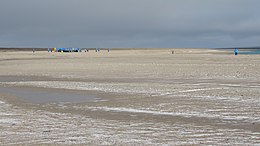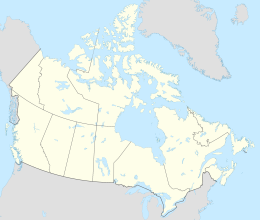geo.wikisort.org - Island
Qikiqtaryuaq, formerly Jenny Lind Island,[3] for the Swedish born opera singer, Jenny Lind, is a small island 420 km2 (160 sq mi) in the Kitikmeot Region of Nunavut, Canada. The island is located in the Queen Maud Gulf, about 120 km (75 mi) southeast of Cambridge Bay.
Native name: Qikiqtaryuaq | |
|---|---|
 Tourists exploring Jenny Lind Island, 2019 | |
 Qikiqtaryuaq  Qikiqtaryuaq | |
| Geography | |
| Location | Queen Maud Gulf |
| Coordinates | 68°43′17″N 102°02′12″W[1] |
| Archipelago | Arctic Archipelago |
| Area | 420 km2 (160 sq mi) |
| Highest elevation | 80 m (260 ft) |
| Administration | |
Canada | |
| Territory | Nunavut |
| Region | Kitikmeot |
| Demographics | |
| Population | Uninhabited |
The island is the site of CAM-1A (Jenny Lind Island), a former Distant Early Warning Line site and home to the unmanned North Warning System site.
Geography

Characteristics of the terrain include rocky ridges, low-lying wetlands, sedge meadows, and a sandy shoreline.
Fauna

Qikiqtaryuaq is a Canadian Important Bird Area (#NU088), and a Key Migratory Terrestrial Bird Site. Notable bird species include Canada goose, lesser snow goose, and Ross's goose.[4]
Muskoxen are found in the south east section of the island.
Climate
| Climate data for Jenny Lind Island Airport (1961-1990) | |||||||||||||
|---|---|---|---|---|---|---|---|---|---|---|---|---|---|
| Month | Jan | Feb | Mar | Apr | May | Jun | Jul | Aug | Sep | Oct | Nov | Dec | Year |
| Record high °C (°F) | −5.1 (22.8) |
−8.8 (16.2) |
−7.8 (18.0) |
2.8 (37.0) |
6.1 (43.0) |
18.3 (64.9) |
22.8 (73.0) |
20.6 (69.1) |
15.0 (59.0) |
6.0 (42.8) |
0.6 (33.1) |
−2.8 (27.0) |
22.8 (73.0) |
| Average high °C (°F) | — | — | −26.1 (−15.0) |
−17.3 (0.9) |
−5.8 (21.6) |
3.2 (37.8) |
9.6 (49.3) |
7.2 (45.0) |
1.0 (33.8) |
−7.5 (18.5) |
−19.2 (−2.6) |
−25.1 (−13.2) |
— |
| Daily mean °C (°F) | — | — | −29.9 (−21.8) |
−21.6 (−6.9) |
−9.3 (15.3) |
0.7 (33.3) |
6.1 (43.0) |
4.5 (40.1) |
−0.9 (30.4) |
−10.4 (13.3) |
−22.7 (−8.9) |
−28.6 (−19.5) |
— |
| Average low °C (°F) | −37.2 (−35.0) |
−37.4 (−35.3) |
−34.6 (−30.3) |
−26.1 (−15.0) |
−13.0 (8.6) |
−1.9 (28.6) |
2.6 (36.7) |
1.7 (35.1) |
−3.0 (26.6) |
−13.6 (7.5) |
−26.7 (−16.1) |
−33.2 (−27.8) |
−18.5 (−1.3) |
| Record low °C (°F) | −51.2 (−60.2) |
−51.2 (−60.2) |
−50.0 (−58.0) |
−43.3 (−45.9) |
−30.6 (−23.1) |
−17.2 (1.0) |
−2.8 (27.0) |
−7.8 (18.0) |
−16.7 (1.9) |
−33.2 (−27.8) |
−42.8 (−45.0) |
−47.2 (−53.0) |
−51.2 (−60.2) |
| Average precipitation mm (inches) | 2.2 (0.09) |
2.4 (0.09) |
2.7 (0.11) |
3.9 (0.15) |
5.9 (0.23) |
10.6 (0.42) |
19.6 (0.77) |
25.9 (1.02) |
18.6 (0.73) |
14.0 (0.55) |
5.5 (0.22) |
3.0 (0.12) |
114.3 (4.50) |
| Source: 1961-1990 Environment and Climate Change Canada[5] | |||||||||||||
History
The island is uninhabited but still has an active North Warning System. Originally part of the Distant Early Warning Line, the site is known as CAM-1.
References
- "Qikiqtaryuaq". Geographical Names Data Base. Natural Resources Canada.
- "Qikiqtaryuaq". Geographical Names Data Base. Natural Resources Canada.
- "Jenny Lind Island". Geographical Names Data Base. Natural Resources Canada.
- "Jenny Lind Island". Important Bird and Biodiversity Areas in Canada. Retrieved 2014-01-05.
- Environment and Climate Change Canada—Canadian Climate Normals 1961–1990. Retrieved 22 June 2011.
На других языках
[de] Jenny Lind Island
Jenny Lind Island (Inuktitut: Qikiqtarjuaq)[1] ist eine 420 km² große Insel in der Kitikmeot-Region des kanadischen Territoriums Nunavut.[2][3]- [en] Qikiqtaryuaq
[fr] Île Jenny Lind
L'île Jenny Lind est une île de 420 km2 située dans le golfe de la Reine-Maud, dans la région de Kitikmeot, au Nunavut (Canada). Elle a été nommée en l'honneur de la chanteuse d'opéra suédoise Jenny Lind.[ru] Дженни-Линд (остров)
Дженни-Линд (англ. Jenny Lind Island) — остров Канадского Арктического архипелага. Назван в честь знаменитой оперной певицы, "шведского соловья" Йенни Линд. В настоящее время остров необитаем (2012).Другой контент может иметь иную лицензию. Перед использованием материалов сайта WikiSort.org внимательно изучите правила лицензирования конкретных элементов наполнения сайта.
WikiSort.org - проект по пересортировке и дополнению контента Википедии